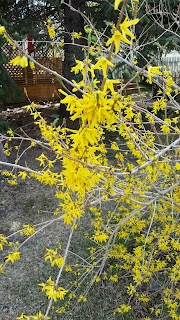I got this on deep discount when I worked at a local greenhouse, not thinking it would even grow that well here, as I've never seen them before. To my surprise this selection from Proven Winners exceeds in my Calgary garden! It is one of the first to leaf out in the spring in bright chartreuse followed by delicate tubular flowers in June. The leaves are attractive all summer and in a warm enough fall turn a variety of pink to red shades. It seems to require no care and thrives in a pretty hot and dry spot with poor soil in my yard.
Weigela , Centennial
I had read many years ago that the variety "Centennial" was the hardiest of the Wiegelas which is very true. Don't mess around with the little dwarf varieties I don't see them growing very successfully in our area. This Wiegela has been moved once and grows inbetween and under some other shrubs and still would like to grow over 6 feet tall! I always say it is very underused on the prairies, the only one I've ever seen was at the Calgary Zoo many years ago. Although it has a relatively short bloom time, the blooms are worth it, a large tubular red-pink flower that lasts a few weeks in June and July, I've read if you trim and fertilize them in midsummer they will rebloom. I find the leaves and plant relatively attractive thru the summer, in the fall it turns a pale yellow.
Lilac, Tinkerbelle
These little lilacs have gained in popularity over the last decade probably because they are all kinds of awesome! The variety Tinkerbelle is the one pictured here, there is also one called Little Kim which has larger leaves, similar in many ways but I prefer Tinkerbelle. This lilac has a nice compact and uniform shape, I trim off any long leaders in the summer to keep the shape round, this should take anyone around 5 minutes to do! After a couple of years this shrub really takes off, the flowers are profuse and fragrant like you want a lilac to be. After flowering I often trim off the old flower heads just for a tidy look, it's not necessary it just depends on what you like. In the fall these turn yellow-bronze and drop their leaves almost in a single day.
Boxwood, Green Velvet
I planted this boxwood 15 years ago and it seems to do just fine in our zone. Perhaps you've seen this plant in Europe?, often used in formal knot gardens or as a high evergreen hedge. I don't think it will grow as large as the hedgerows in England but it will be evergreen! I see these more and more around the city so I'm glad Calgarians are taking a little risk once in a while! Just a few tips to grow a boxwood in Calgary; grow close to a heated building such as the foundation of your house, avoid winter sun and too dry a location, mine is on the North side of the house, ie; lots of snowcover all winter, I think an East facing exposure would be fine too, keep moist, they are evergreen and need help during our desiccating high winds, water well into the fall until freeze up.
Forsythia
I spotted this one in my neighbourhood recently, I find Forsythia so cheerful in the early spring, often the first colour of the season. These shrubs are pretty easy to grow as a foundation planting, trimmed into a hedge or as a natural shape on a lawn. The main attraction happens in April however, so the rest of the year it is a demure green leafed shrub so plan accordingly, you may want to offset the greenery with some other flowering shrub or contrasting foliage.
Sumac, Tiger Eyes
I gave one of these to a friend a few years ago and it did just fine in Calgary, seems to thrive in a hot location and even in poor soil too! There are a few at the Calgary Zoo planted against the Africa building. The long frond type leaves give a tropical look and are a yellow-chartreuse all summer, in the fall Tiger Eyes turns various shades of orange-red, after a few years the plant will produce the red cones all sumacs have which stay on thru the winter. Also, like all sumacs, after some years they produce suckers so either plant in an area where this won't bother you or the garden or just dig them out in the spring, hey, free sumacs! This variety will not grow very tall so is well suited to foundation plantings or small spaces, a very interesting and underused ornamental on the prairies.
Mock Orange, Philidelphus
Apparently Mock Orange was very popular in the Mid-Century as there are many in my neighbourhood. Who knows why this plant was named for an orange? Orange flowers are white and the shrub has a pleasant almost orangey fragrance, either way they are terrific! Apparently there are many new cultivars with bigger flowers and smaller stature, like over 8 feet of fragrant white flowers are a problem? They must be pretty easy to grow as there are many on my street. Like many flowering shrubs these guys bloom on old wood so prune just after flowering, which is late May or June in Calgary. The dark green foliage is also attractive all summer.












No comments:
Post a Comment